OpenSees Cloud
OpenSees AMI
Murum, cura te ipsum
Original Post - 02 Sep 2024 - Michael H. Scott
Show your support at Buy Me a Coffee.
OpenSees has its fair share of element implementations that are computationally inefficient. Fortunately, most of those elements are never used.
But among elements that are used, SFI-MVLEM is the undisputed champion.
Whereas the standard MVLEM element uses a uniaxial material in each fiber, the SFI-MVLEM element accounts for the interaction of axial and shear stress (\(\sigma_{11}\) and \(\sigma_{12}\)) in each fiber using a plane stress NDMaterial. The only challenge is the normal stress, \(\sigma_{22}\), must be zeroed out in each fiber.
To enforce \(\sigma_{22}\)=0 in each fiber, the element adds a node to the domain–one node for each fiber. Each node has only one DOF and its resisting force is proportional to the fiber’s \(\sigma_{22}\) stress. So, if the global solution reaches zero residual, each fiber will be in a state of zero normal stress. Makes sense. It works.
But letting the global solution zero out fiber stresses is like throwing your garbage out on the street then admiring your clean home.
And, like throwing your garbage out on the street, those additional nodes cause huge global problems.
Consider the minimal shear wall example from a previous post. A 3D model is shown, but the issues apply to 2D models as well.
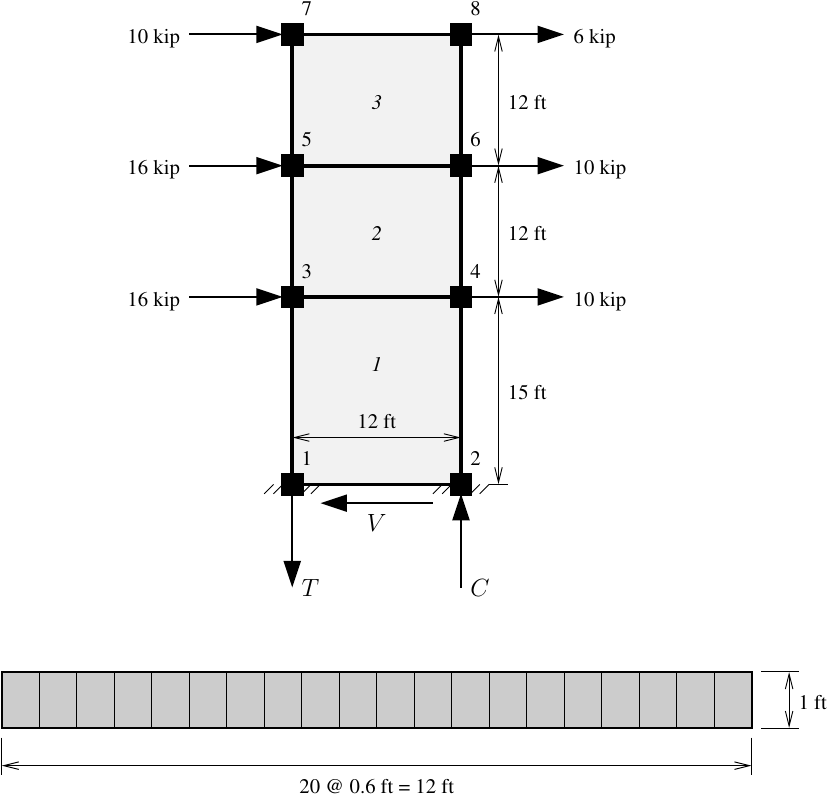
The definition of nodes and loads is identical to the previous post; the only difference is the material and element definition. Here an elastic-isotropic material is used, so the analysis should be simple.
N = 20 # Fibers
Ec = 3600*ksi
nu = 0.25
b = 1*ft
h = 12*ft
ops.nDMaterial('ElasticIsotropic',1,Ec,nu)
conc = [1]*N
bList = [b]*N
hList = [h/N]*N
ops.element('SFI_MVLEM',1,1,2,4,3,N,0.4,'-thick',*bList,'-width',*hList,'-mat',*conc,'-Eave',Ec)
ops.element('SFI_MVLEM',2,3,4,6,5,N,0.4,'-thick',*bList,'-width',*hList,'-mat',*conc,'-Eave',Ec)
ops.element('SFI_MVLEM',3,5,6,8,7,N,0.4,'-thick',*bList,'-width',*hList,'-mat',*conc,'-Eave',Ec)
Four obvious problems with the SFI-MVLEM element implementation are described below. But I didn’t write this post to point out problems and not offer solutions–that would be complaining, not writing–so, a mitigation strategy is offered for each issue.
1. Inconsistent Tangent
The first thing you will notice when running the minimal wall example with SFI-MVLEM elements is the excessive number of iterations. Remember, the wall constitutive model is linear-elastic, so equilibrium should be found in one iteration. But the analysis takes 18 iterations with the Newton-Raphson algorithm.
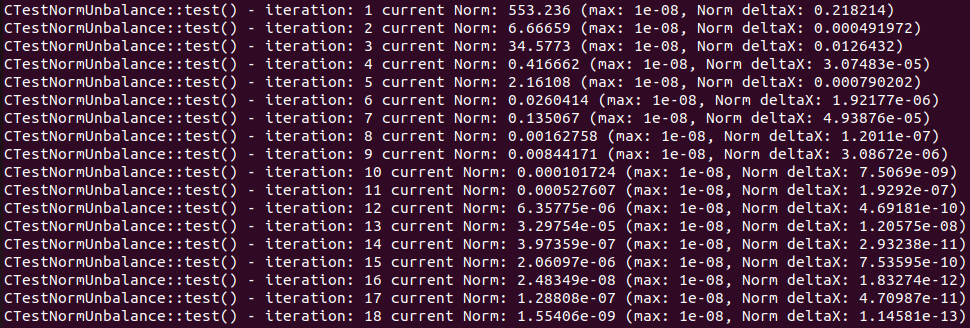
The slow convergence for linear response indicates an inconsistent
tangent coming from the element. I haven’t confirmed the source of the
inconsistent tangent, but I suspect the separation of the 22 from the 11
and 12 terms in the fiber tangent is not handled properly. There needs
to be some static condensation, akin to what happens in the
BeamFiber2dPS wrapper class, but I don’t see that happening in the
SFI-MVLEM source code. Making matters worse, it appears the SFI-MVLEM
ignores the tangent terms that couple axial and shear stresses in each
fiber.
Mitigation
Use the Krylov-Newton algorithm, which can be effective at dealing with sloppy tangents. For this minimal wall example, the Krylov-Newton algorithm requires only four iterations.
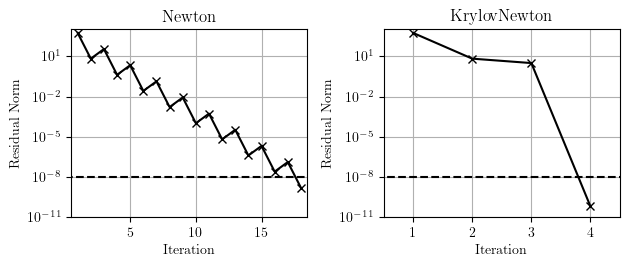
OK, this issue has nothing to do with the additional internal nodes. But, as shown in the next two issues, those additional nodes make for more equations, and more equations translates to longer solve times. So, if you have to sit through more iterations because of an inconsistent tangent, you will notice longer run times, particularly for large models.
2. System Size
Using standard MVLEM elements for this simple wall model, the system
size is 42 equations, but with the SFI-MVLEM elements, the system size
is 102 equations. The resulting topologies of the stiffness matrix are
shown below (using Plain numberer).
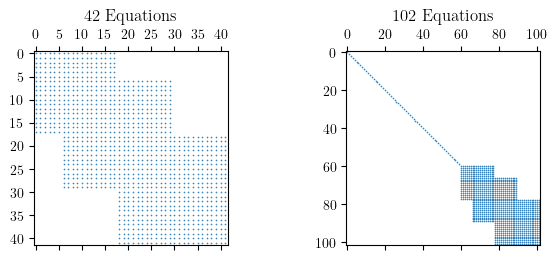
Both matrices have the same bandwidth (about 25), but due to the additional equations, the SFI-MVLEM model will have longer solve times, especially if you use a solver that assumes banded matrix storage or, even worse, full matrix storage. And the number of equations and solve time only go up if you increase the number of fibers in each SFI-MVLEM element.
Mitigation
If you must use SFI-MVLEM elements, use as few fibers as possible.
3. Equation Numbering
Compounding the longer solve times, the default equation numberer,
RCM, and the lesser used AMD, can produce larger matrix bandwidths
than the Plain numberer. The equation numbering algorithms deal with
the extra SFI-MVLEM nodes in their own ways.
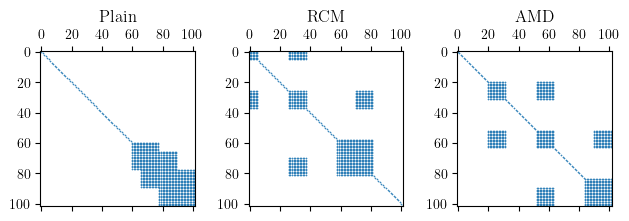
This may be the only case where using RCM is significantly worse than
the Plain numberer. But for larger models, you’ll probably be better
off sticking wtih RCM for the equation numbering.
Mitigation
Use a linear equation solver with sparse matrix storage, e.g.,
UmfPack, SparseGeneral, or Mumps. With sparse matrix storage, the
topology of the stiffness matrix and the equation numbering don’t matter
much, only the number of non-zero matrix entries.
4. Internal Node Tags
Although the model has eight user-defined nodes, if you print out the
list of node tags (using ops.getNodeTags()), you will see there are 68
nodes defined in the domain–the eight nodes plus 60 nodes, one for each
of the 20 fibers in each of the three elements.

For each element, the internal node tags range from -(1000*eleTag+1) to
-(1000*eleTag+Nfibers), e.g., element 2 creates nodes with tags -2001 to
-2020.
Mitigation
There’s no getting around this implementation choice. Avoid defining nodes with negative tags–something that OpenSees allows. Similarly, don’t define SFI-MVLEM elements with negative tags as this could lead to collisions with positive node tags defined elsewhere in your model.
Conclusions
Using the default analysis options in OpenSees, you can experience unncessarily long run-times in the analysis of SFI-MVLEM models. If you have to stick with the SFI-MVLEM elements, remember the following:
- Use as few fibers as possible
- Use a sparse matrix solver like UmfPack or Mumps
- Use the Krylov-Newton algorithm
- Be careful using negative node tags elsewhere in your model
If you have some latitude, take a small step over to the E-SFI-MVLEM element, which is the cura te ipsum for SFI-MVLEM. The element assumes an empirically derived shape function for the \(\varepsilon_{22}\) strain field so that the problematic internal nodes are not required. The “E” at the front of E-SFI-MVLEM stands for “Efficient”, which is not an inaccurate description, but some minor issues remain.